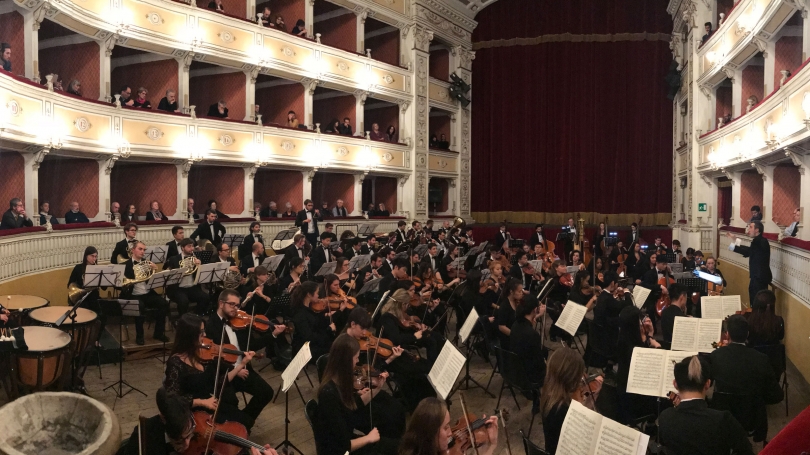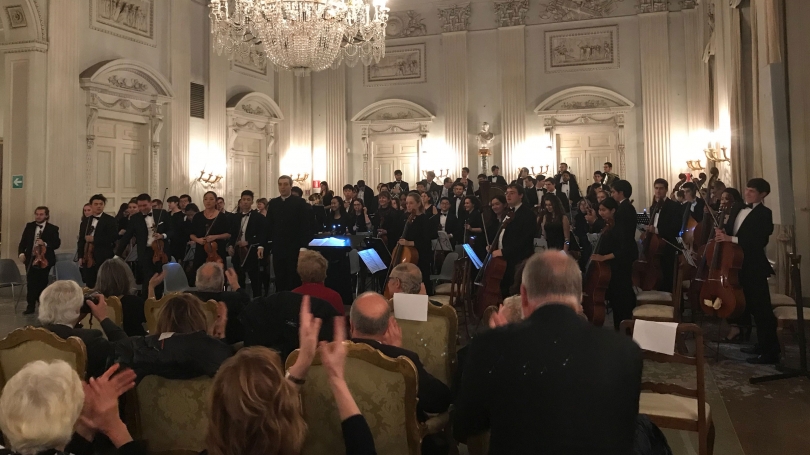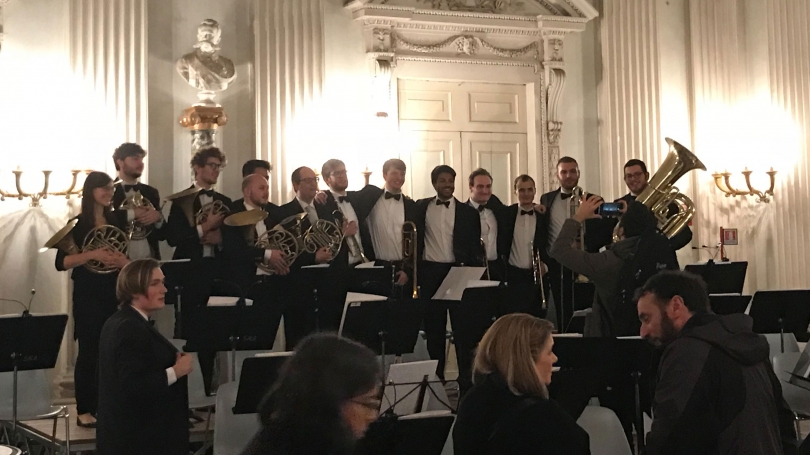DSO Travel Diary: Italian Tour
This past winterim as some Dartmouth students sat on couches, the Dartmouth Symphony Orchestra undertook a 10-day concert tour of Italy, along with Hop members at the “Bentley Fellow” level and above and donors who have endowment funds that support ensemble tours. Follow their trip as documented by Laura Jeliazkov ’18, a flautist with the DSO.
Day One, Monday. The Dartmouth Symphony Orchestra loads 45 musicians, 47 suitcases and 36 instruments onto a bus in the 6 am darkness of Hanover. Leaving is slightly delayed by the percussionist’s failure to wake up to his alarm. A four-hour bus ride to JFK, a six-hour wait at the gate, a nine-hour flight to Milan, a four-hour bus ride to Florence, and the musicians arrive for their first afternoon in Italy.
Day Two, Tuesday. The first of three six-hour rehearsals. The Dartmouth Symphony Orchestra meets its Italian counterpart – students of the Orchestra Toscana dei Conservatori. Dartmouth conductor Filippo Ciabatti is joined by Maestros Gabriele Falcioni and Massimo Niccolai in instruction and preparation of this combined orchestra. The location is a stunning room in the Villa Poggio Imperiale, a villa which today houses a women’s college but which once housed the grand-ducal court – before which a 14-year-old Mozart performed in concert the year 1770. Marble busts, stucco friezes, an ornately carved ceiling and a crystal teardrop chandelier have the musicians – American and Italian alike – snapping photos and gazing around in wonder all through the six hours.
Day Three, Wednesday. Another full day of rehearsal. Lunch hour is taken on a stone wall at the edge of the villa grounds with a vista of the Florence countryside. Some musicians wander up the hill to the neighboring Arcetri Astrophysical Observatory, from where there’s an even better view.
Day Four, Thursday. Final day of rehearsal. The musicians are in good spirits, but certainly tired. What keeps them going is the exciting evening coming up: dinner to be held at the bed-and-breakfast run by Maestro Ciabatti’s mother. Sponsors of the 2018 tour attend to meet the musicians. A seven-course meal of Tuscan specialties, a steady supply of digestivos, and then a round of group photos does not disappoint.
Day Five, Friday. A day off, before the first concert set for 9 pm that night. Musicians are free to explore the city on their own, until dinner at the hotel; then, the concert-life begins. The venue is the room in the Villa Poggio. The high ceilings make for an impressively resonant performance of Mahler’s Symphony No. 5.
Day Six, Saturday. A full day off – no rehearsal, no concert. The orchestra sets out on a guided tour through Florence proper, and then up into the hills above.
Day Seven, Sunday. Day of the second concert, this time in Montepulciano, a small medieval town at the top of a hill covered in vineyards. The proscenium theater in Teatro Poliziano is small and the orchestra too large to fit on the stage; the orchestra is therefore positioned instead in the audience orchestra section. The setting is intimate and the musical balance better, as the acoustics are not nearly as wild as in the villa concert hall. The concert is a success. The 11 pm silence of the narrow cobbled streets of Montepulciano is broken by the orchestra’s celebratory voices pouring out of a nearby restaurant at a reception following.
Day Eight, Monday. The third concert, in Lucca – a Tuscan city still surrounded by its original Renaissance walls. Musicians are greeted by the cavernous, dark and freezing Gothic-style space of the Chiesa di San Francesco church. Rehearsal and sound-check run with most still wrapped in jackets and scarves; the orchestra warms up not only their instruments but themselves in the heated coat-room during break. The church fills with the warmth of a full audience by concert-time though, and concert number three also runs very well. The third-movement French horn solo, played by Maestro G. Falcioni, seems to travel all the way down the hall and back, right beneath the high stone vaults of the church ceiling.
Day Nine, Tuesday. The final concert is in Siena, at the Teatro dei Rinnovati. The space is another proscenium theater, with a warm red-and-green color palette and incredibly ornate designs. This time the orchestra fits the stage. The evening is sold out, everyone is in good spirits; by this point the Italians and the Americans mingle and chat and laugh together. Mahler’s Fifth is a success, and the second piece – Bernstein’s overture to the operetta of Voltaire’s Candide – is demanded a second time for encore.
Day Ten, Wednesday. The music is over – for now. All that’s left is a final day of viewing, tasting and appreciating the beautiful city of Florence. A final dinner is hosted at the hotel restaurant; the orchestra toasts to all that the Fall of 2018 was in preparation, and to all that the last ten days is as the beginning of a musical partnership and collaboration with the Tuscan musicians and the Hopkins Center for the Arts at Dartmouth College. The DSO would like to thank its sponsors and its friends for making possible, and for watching, this journey.
Tucked away in a corner of the lobby, behind the chipped clay bust of a woman’s head and a pile of fashion magazines, the hotel in Florence has a modest, one-shelf library. Discovered among the binds was a copy of Voltaire’s Candide: our encore piece.



